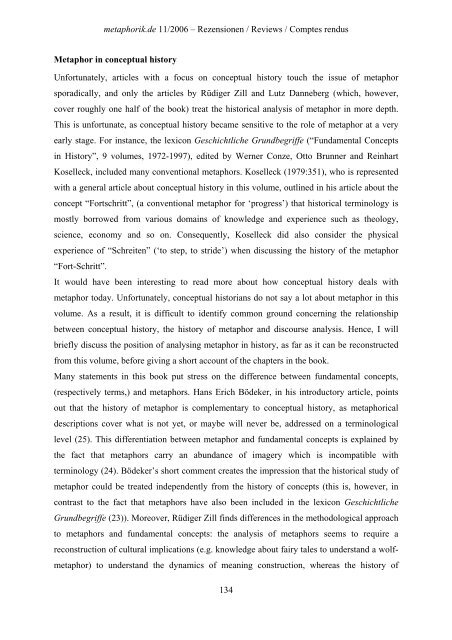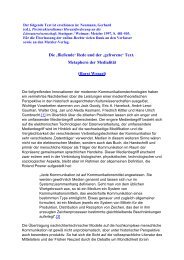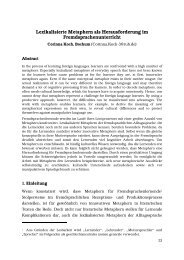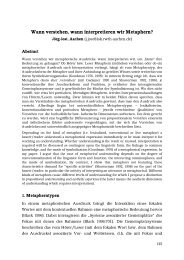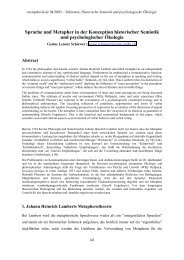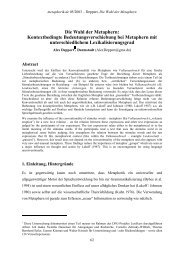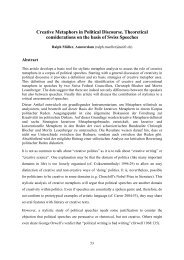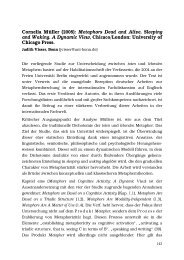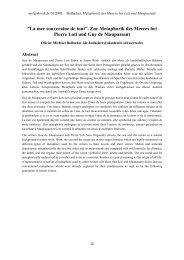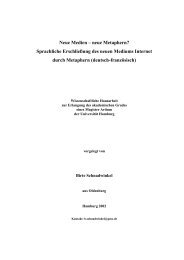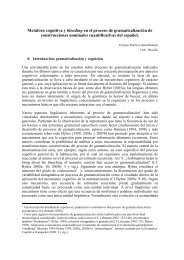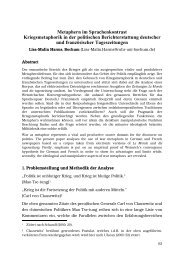Hans Erich Bödeker - metaphorik.de
Hans Erich Bödeker - metaphorik.de
Hans Erich Bödeker - metaphorik.de
You also want an ePaper? Increase the reach of your titles
YUMPU automatically turns print PDFs into web optimized ePapers that Google loves.
<strong>metaphorik</strong>.<strong>de</strong> 11/2006 – Rezensionen / Reviews / Comptes rendus<br />
Metaphor in conceptual history<br />
Unfortunately, articles with a focus on conceptual history touch the issue of metaphor<br />
sporadically, and only the articles by Rüdiger Zill and Lutz Danneberg (which, however,<br />
cover roughly one half of the book) treat the historical analysis of metaphor in more <strong>de</strong>pth.<br />
This is unfortunate, as conceptual history became sensitive to the role of metaphor at a very<br />
early stage. For instance, the lexicon Geschichtliche Grundbegriffe (“Fundamental Concepts<br />
in History”, 9 volumes, 1972-1997), edited by Werner Conze, Otto Brunner and Reinhart<br />
Koselleck, inclu<strong>de</strong>d many conventional metaphors. Koselleck (1979:351), who is represented<br />
with a general article about conceptual history in this volume, outlined in his article about the<br />
concept “Fortschritt”, (a conventional metaphor for ‘progress’) that historical terminology is<br />
mostly borrowed from various domains of knowledge and experience such as theology,<br />
science, economy and so on. Consequently, Koselleck did also consi<strong>de</strong>r the physical<br />
experience of “Schreiten” (‘to step, to stri<strong>de</strong>’) when discussing the history of the metaphor<br />
“Fort-Schritt”.<br />
It would have been interesting to read more about how conceptual history <strong>de</strong>als with<br />
metaphor today. Unfortunately, conceptual historians do not say a lot about metaphor in this<br />
volume. As a result, it is difficult to i<strong>de</strong>ntify common ground concerning the relationship<br />
between conceptual history, the history of metaphor and discourse analysis. Hence, I will<br />
briefly discuss the position of analysing metaphor in history, as far as it can be reconstructed<br />
from this volume, before giving a short account of the chapters in the book.<br />
Many statements in this book put stress on the difference between fundamental concepts,<br />
(respectively terms,) and metaphors. <strong>Hans</strong> <strong>Erich</strong> <strong>Bö<strong>de</strong>ker</strong>, in his introductory article, points<br />
out that the history of metaphor is complementary to conceptual history, as metaphorical<br />
<strong>de</strong>scriptions cover what is not yet, or maybe will never be, addressed on a terminological<br />
level (25). This differentiation between metaphor and fundamental concepts is explained by<br />
the fact that metaphors carry an abundance of imagery which is incompatible with<br />
terminology (24). <strong>Bö<strong>de</strong>ker</strong>’s short comment creates the impression that the historical study of<br />
metaphor could be treated in<strong>de</strong>pen<strong>de</strong>ntly from the history of concepts (this is, however, in<br />
contrast to the fact that metaphors have also been inclu<strong>de</strong>d in the lexicon Geschichtliche<br />
Grundbegriffe (23)). Moreover, Rüdiger Zill finds differences in the methodological approach<br />
to metaphors and fundamental concepts: the analysis of metaphors seems to require a<br />
reconstruction of cultural implications (e.g. knowledge about fairy tales to un<strong>de</strong>rstand a wolfmetaphor)<br />
to un<strong>de</strong>rstand the dynamics of meaning construction, whereas the history of<br />
134


